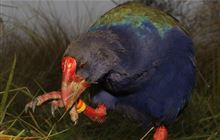Takahē population 100 breeding pairs strong
Archived content: This media release was accurate on the date of publication.
Introduction
The official yearly takahē population count is in, with 347 birds recorded throughout the country – a 13 percent increase in the last year.Date: 20 October 2017
Of those 347 birds, more than two thirds are coupled up. The takahē population now includes more than 100 breeding pairs.
DOC's Senior Takahē Ranger Glen Greaves says the Takahē Recovery Programme is thrilled with the results.
"This is the highest annual growth rate recorded in the population since management began almost 70 years ago.
"Like race horses, all takahē share their birthday. October 1 marks the beginning of the takahē calendar year. This is when the previous summer's chicks are a year old and can be included into the total population count," says Glen Greaves.
Along with the success of the growing population, the programme has passed the 100-breeding pair milestone for the first time on record. This is more than double the number of breeding pair, 10 years ago.
"This is significant as the number of breeding pair is the most accurate measure of population heath. A total population number can give false security, if there is a significant age or sex bias," says Glen Greaves.
Sandra Cook, the Ngāi Tahu representative on the Takahē Recovery Group says "Witnessing the current success of the takahē program is both humbling and inspirational. Takahē are a taonga species for Ngāi Tahu and our aspiration is to see them, once again, running free throughout their traditional range.
"The dedication and determination of DOC staff, to the recovery of takahē as a species, is paying dividends and they are to be congratulated."
As the population grows there is more certainty for the future of the takahē. The species has recently moved two steps away from extinction according to the New Zealand Threat Classification System. The recovery programme is confident the number of takahē will increase by at least 10 percent after this summer's breeding season.
With the population increasing, new sanctuary sites to house the takahē have doubled in the past 10 years. This provides an important safeguard for the species should disaster strike the only wild population.
"Now the focus is on creating new wild populations, in areas where takahē once existed," says Glen Greaves.
"With the reintroduction of takahē in Kahurangi National Park - planned for early next year - and the drive for a Predator Free NZ by 2050, DOC with the support of their national partner Fulton Hogan, are working hard towards this vision."
Contact
For media enquiries contact:
Email: media@doc.govt.nz


